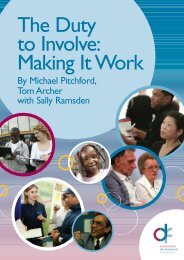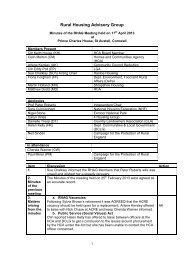Rapid Evidence Assessment of the Research ... - Rural Housing
Rapid Evidence Assessment of the Research ... - Rural Housing
Rapid Evidence Assessment of the Research ... - Rural Housing
You also want an ePaper? Increase the reach of your titles
YUMPU automatically turns print PDFs into web optimized ePapers that Google loves.
Future trends<br />
To what extent (if any) have second homes increased house prices; and have <strong>the</strong>y crowded out prospective first-time buyers?<br />
95. An important question is <strong>the</strong> likely trajectory <strong>of</strong> <strong>the</strong> second homes market and, whilst it is not possible to<br />
predict price trends, Gilbert (2001) identified a number <strong>of</strong> demographic trends <strong>of</strong> significance to <strong>the</strong> potential<br />
growth <strong>of</strong> <strong>the</strong> second homes market:<br />
• <strong>the</strong> largest growth in <strong>the</strong> population to 2021 will be among 50 to 64 year olds, predominantly baby<br />
boomers born in <strong>the</strong> 1950s and 1960s who will be approaching retirement and who may be attracted to<br />
owning a second home; and<br />
• those aged 65 and over, are projected to increase by 32 per cent between 1996 and 2021, who may be<br />
attracted to owning a second retirement home.<br />
96.<br />
As Gilbert states:<br />
“Much will depend on whe<strong>the</strong>r more households choose and/or are able to release equity from <strong>the</strong>ir main<br />
residence and house prices continue to appreciate steadily in <strong>the</strong> coming years. Interest rates need also to<br />
remain stable and relatively low. For <strong>the</strong> baby boomers contemplating retirement, property will in many<br />
cases be bound up with a choice <strong>of</strong> lifestyle. A second home will be part <strong>of</strong> that lifestyle be it close to a golf<br />
course/yachting marina, in a smart city centre or even as an alternative to investment in equities” (Gilbert,<br />
2001, p38).<br />
97. The 2005 Direct Line Study estimated that <strong>the</strong> number <strong>of</strong> UK second homes was to rise by 24 per cent by<br />
2015, increasing from 328,000 to 405,000 by 2015. This increase <strong>of</strong> 77,000 second homes means an average<br />
annual growth <strong>of</strong> 3.2 per cent. This would suggest that second homes in England could increase by an<br />
average 7,700 per year (from a base <strong>of</strong> 241,000). This though would depend on economic circumstances.<br />
1 The model used was developed as part <strong>of</strong> an earlier study published by <strong>the</strong> JRF study in May 2007, entitled Transforming Places:<br />
housing investment and neighbourhood market change.<br />
29






